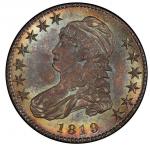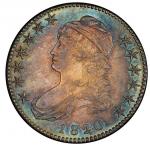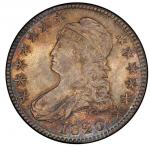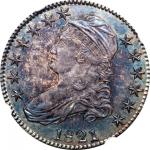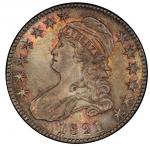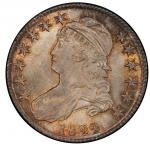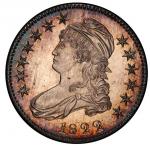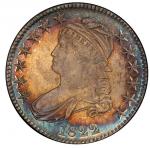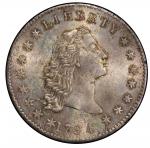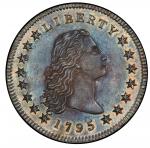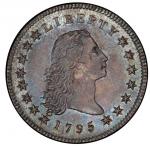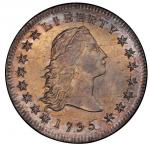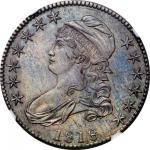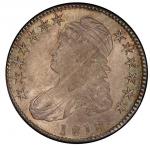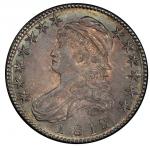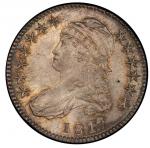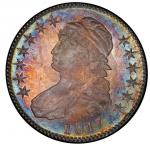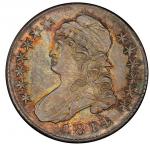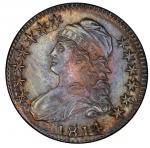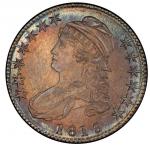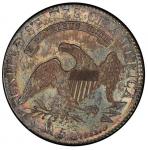The policy of our government has been to issue a great preponderance of halves, and the smaller denominations of coins, under the impression that they would be less likely to be exported from the country. -- J.L. Riddell, melter and refiner of the New Orleans Mint, 1845.Beautiful and highly lustrous, this half dollar exhibits a bright rose-gold central obverse ringed in pastel blue with hints of champagne gold, while the reverse is pleasing baby blue, gold, violet, and deep gray. Resounding cartwheel spins over both sides. The strike is very sharp, showing fine detail nearly everywhere but the centers of the lowest two stars on each side. Careful examination finds some light hairlines and a few scattered contact marks, including a couple just inside the rim at 12:00 on the reverse and a small batch above 50 at the base of that side. Star 2 is notably recut, with an extra disconnected point raised in the space to the stars upper left. The reverse shows a network of die cracks, including an arc from the leftmost olive leaves to the left end of the motto banner and another broad arc from the rim above ST of STATES through the bases of UNUM and the centers of each arrowhead to the rim below 50. A final nearly horizontal crack crosses the talons and intersects the rim beyond the olive leaves.The overdate aspect was largely effaced from the die, but recutting is visible below the final date digit under low magnification. Of the 14 different obverse dies employed to strike half dollars of this date, five were 1819/8 overdates. Four of these, including this one, featuring a "large 9" in the date, while the "small 9" appears only on the Overton-101. This obverse is unique to the Overton-104 die marriage.The year 1819 marked an enormous milestone in the history of the half dollar. While mintages over one million pieces had been typical since 1808, never before had the U.S. Mint coined over two million half dollars. Throughout the 1820s, mintages of more than three million half dollars became commonplace, swelling to over 6.5 million in 1836, the highest mintage of the denomination until the 1850s. Even after the reintroduction of the silver dollar, haltingly in 1836 and earnestly in 1840, the half dollar continued to be by far the most numerous silver coin, and would remain so until the silver strikes of the Comstock were laundered into government coffers as largely unwanted silver dollars beginning in 1878.The present coin was struck amidst the first bank panic in American history, when falling commodity prices, overissued paper money, and a land bubble conspired to create a trade imbalance and a run on the banks. Contemporary newspapers described a "demand of payment in specie," not the paper issues of overextended state and local banks, "the large importations of which by the Bank of the United States [come] at a great expense." Forced to buy Spanish silver on the international market at advanced prices, it makes sense that the Bank of the United States and other large banks would seek to convert those coins into half dollars at the Mint, coins that contained less silver value but were accepted at the same rate as their Spanish counterparts in overseas markets. "The American dollar is intrinsically worth about one per cent less than the Spanish milled dollar," reported Secretary of the Treasury William H. Crawford in his Report on Currency, delivered to Congress in February 1820. While shipping and insurance costs would have eaten up any profits to be derived by shipping the coins out of the country at a 1% profit, no such costs burdened depositors at the Mint. Thus, large banking institutions could convert $10,000 worth of Spanish 8 reales into $10,100 worth of half dollars, an advantage worth taking considering the proximity of the Bank of the United States (at 4th and Chestnut in Philadelphia) to the Philadelphia Mint (at 7th and Filbert, less than a half mile away). The mintage of half dollars swelled in 1819 as the bank run crested, with millions of half dollars paid out under duress but very few saved. In 1820, as depression sunk in, mintages decreased to under a million. As the economic stress lifted, mintages of Americas largest silver coin again increased, passing 3.5 million in 1824.The Overton-Parsley census cites a single MS-66 as finest known from these dies, followed by two MS-65 coins and two graded MS-64. One MS-65 piece is the Overton plate coin in the 3rd, 4th, and 5th editions, a coin included in the July 1993 Sheridan Downey mail bid sale of "Selections from the Al C. Overton Collection," a group of just over 300 coins that were privately sold en masse before the public sale was conducted. Another is the PCGS MS-65 sold in our August 2012 ANA sale.

